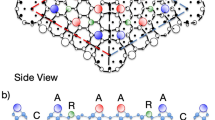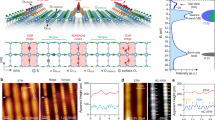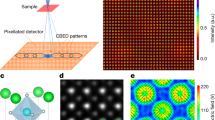Abstract
The determination of the atomic structure and the retrieval of information about reconstruction and bonding of metal oxide surfaces is challenging owing to the highly defective structure and insulating properties of these surfaces. Transmission electron microscopy (TEM) offers extremely high spatial resolution (less than one ångström) and the ability to provide systematic information from both real and reciprocal space. However, very few TEM studies1,2,3 have been carried out on surfaces because the information from the bulk dominates the very weak signals originating from surfaces. Here we report an experimental approach to extract surface information effectively from a thickness series of electron energy-loss spectra containing different weights of surface signals, using a wedge-shaped sample. Using the (001) surface of the technologically important compound strontium titanate, SrTiO3 (refs 4, 5, 6), as a model system for validation, our method shows that surface spectra are sensitive to the atomic reconstruction and indicate bonding and crystal-field changes surrounding the surface Ti cations. Very good agreement can be achieved between the experimental surface spectra and crystal-field multiplet calculations based on the proposed atomic surface structure optimized by density functional calculations3. The distorted TiO6−x units indicated by the proposed model can be viewed directly in our high-resolution scanning TEM images. We suggest that this approach be used as a general method to extract valuable spectroscopic information from surface atoms in parallel with high-resolution images in TEM.
This is a preview of subscription content, access via your institution
Access options
Subscribe to this journal
Receive 51 print issues and online access
$199.00 per year
only $3.90 per issue
Buy this article
- Purchase on Springer Link
- Instant access to full article PDF
Prices may be subject to local taxes which are calculated during checkout




Similar content being viewed by others
References
Erdman, N. et al. The structure and chemistry of the TiO2-rich surface of SrTiO3(001). Nature 419, 55–58 (2002)
Enterkin, J. A. et al. A homologous series of structures on the surface of SrTiO3(110). Nature Mater. 9, 245–248 (2010)
Erdman, N. et al. Surface structures of SrTiO3 (001): a TiO2-rich reconstruction with a c(4 x 2) unit cell. J. Am. Chem. Soc. 125, 10050–10056 (2003)
Jiang, Q. D. & Zegenhagen, J. SrTiO3(001) surfaces and growth of ultra-thin GdBa2Cu3O7-x films studied by LEED/AES and UHV-STM. Surf. Sci. 338, L882–L888 (1995)
Silly, F. & Castell, M. R. Growth of Ag icosahedral nanocrystals on a SrTiO3(001) support. Appl. Phys. Lett. 87, 213107 (2005)
Domen, K., Kudo, A. & Onishi, T. Mechanism of photocatalytic decomposition of water into H2 and O2 over NiO-SrTiO3 . J. Catal. 102, 92–98 (1986)
Castell, M. R. Scanning tunneling microscopy of reconstructions on the SrTiO3(001) surface. Surf. Sci. 505, 1–13 (2002)
Cowley, J. M. Electron microscopy of surface structure. Prog. Surf. Sci. 21, 209–250 (1986)
Comon, P. Jutten, C. (eds) Handbook of Blind Source Separation (Academic, 2010)
Inada, H. et al. Atomic imaging using secondary electrons in a scanning transmission electron microscope: experimental observations and possible mechanisms. Ultramicroscopy 111, 865–876 (2011)
Radtke, G. & Botton, G. A. in Scanning Transmission Electron Microscopy (eds Pennycook, S. J. & Nellist, P. D. ) 207–245 (Springer, 2011)
Unser, M., Ellis, J. R., Pun, T. & Eden, M. Optimal background estimation in EELS. J. Microsc. 145, 245–256 (1987)
Pearson, D. H., Ahn, C. C. & Fultz, B. White lines and d-electron occupancies for the 3d and 4d transition metals. Phys. Rev. B 47, 8471–8478 (1993)
LeBeau, J. M., Findlay, S. D., Allen, L. J. & Stemmer, S. Position averaged convergent beam electron diffraction: theory and applications. Ultramicroscopy 110, 118–125 (2010)
Sefat, A. S., Amow, G., Wu, M.-Y., Botton, G. A. & Greedan, J. E. High-resolution EELS study of the vacancy-doped metal/insulator system, Nd1−xTiO3, x = 0 to 0.33. J. Solid State Chem. 178, 1008–1016 (2005)
Höche, T., Grodzicki, M., Heyroth, F. & van Aken, P. A. Assessment of transition-metal coordination in glasses by electron energy-loss spectroscopy. Phys. Rev. B 72, 205111 (2005)
de Groot, F. M. F. et al. Oxygen 1s X-ray absorption of tetravalent titanium oxides: a comparison with single-particle calculations. Phys. Rev. B 48, 2074–2080 (1993)
Muller, D. A., Nakagawa, N., Ohtomo, A., Grazul, J. L. & Hwang, H. Y. Atomic-scale imaging of nanoengineered oxygen vacancy profiles in SrTiO3 . Nature 430, 657–661 (2004)
Uldry, A., Vernay, F. & Delley, B. Systematic computation of crystal-field multiplets for X-ray core spectroscopies. Phys. Rev. B 85, 125133 (2012)
Cowan, R. D. The Theory of Atomic Structure and Spectra (Univ. California Press, 1981)
Kirkland, E. J. Advanced Computing in Electron Microscopy Illustrated edn 289 (Springer, 2010)
Acknowledgements
We are grateful to NSERC for Discovery and Strategic Grants supporting this work. The microscopy was carried out at the Canadian Centre for Electron Microscopy, a National Facility supported by NSERC and McMaster University. G.-z.Z. thanks J. LeBeau for help and advice on the simulations of the PACBEDs.
Author information
Authors and Affiliations
Contributions
G.-z.Z. and G.A.B. conceived and are responsible for the experiments, performed the simulations and jointly wrote the paper. G.R. contributed to the analysis of crystal-field multiplet simulations and the final version of this manuscript.
Corresponding author
Ethics declarations
Competing interests
The authors declare no competing financial interests.
Supplementary information
Supplementary Information
This file contains Supplementary Methods, Supplementary Figures 1-2 and an additional reference. (PDF 216 kb)
Rights and permissions
About this article
Cite this article
Zhu, Gz., Radtke, G. & Botton, G. Bonding and structure of a reconstructed (001) surface of SrTiO3 from TEM. Nature 490, 384–387 (2012). https://doi.org/10.1038/nature11563
Received:
Accepted:
Published:
Issue Date:
DOI: https://doi.org/10.1038/nature11563
This article is cited by
-
Structure inversion asymmetry enhanced electronic structure and electrical transport in 2D A3SnO (A = Ca, Sr, and Ba) anti-perovskite monolayers
Nano Research (2023)
-
Understanding the Behavior of Oxygen Vacancies in an SrFeOx/Nb:SrTiO3 Memristor
Electronic Materials Letters (2022)
-
Local-electrostatics-induced oxygen octahedral distortion in perovskite oxides and insight into the structure of Ruddlesden–Popper phases
Nature Communications (2021)
-
Effects of the Heterointerface on the Growth Characteristics of a Brownmillerite SrFeO2.5 Thin Film Grown on SrRuO3 and SrTiO3 Perovskites
Scientific Reports (2020)
-
Visualizing atomic-scale redox dynamics in vanadium oxide-based catalysts
Nature Communications (2017)
Comments
By submitting a comment you agree to abide by our Terms and Community Guidelines. If you find something abusive or that does not comply with our terms or guidelines please flag it as inappropriate.



